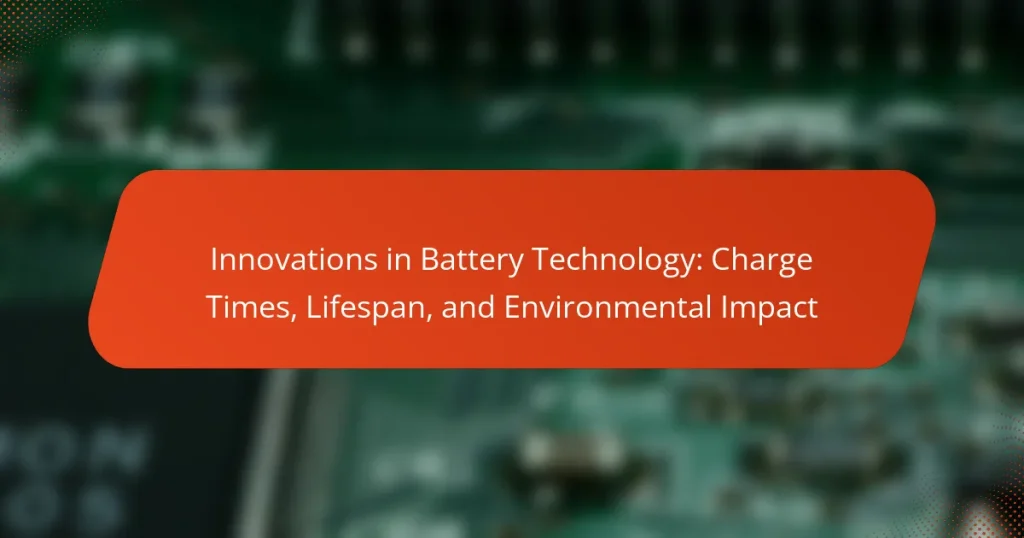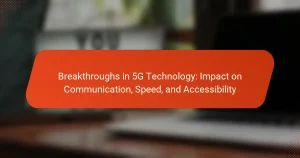Innovations in battery technology focus on advancements that improve charge times, lifespan, and environmental impact. Key developments include solid-state batteries, which enhance energy density and safety by using a solid electrolyte, and lithium-sulfur batteries, which offer higher capacity and lower costs compared to traditional lithium-ion batteries. Fast-charging technologies significantly reduce charging times, making electric vehicles more user-friendly. The article also outlines various battery types, such as lithium-ion, lead-acid, and nickel-metal hydride, and provides practical tips for optimizing battery performance and sustainability. These innovations collectively address critical challenges in energy storage and consumption across multiple industries.
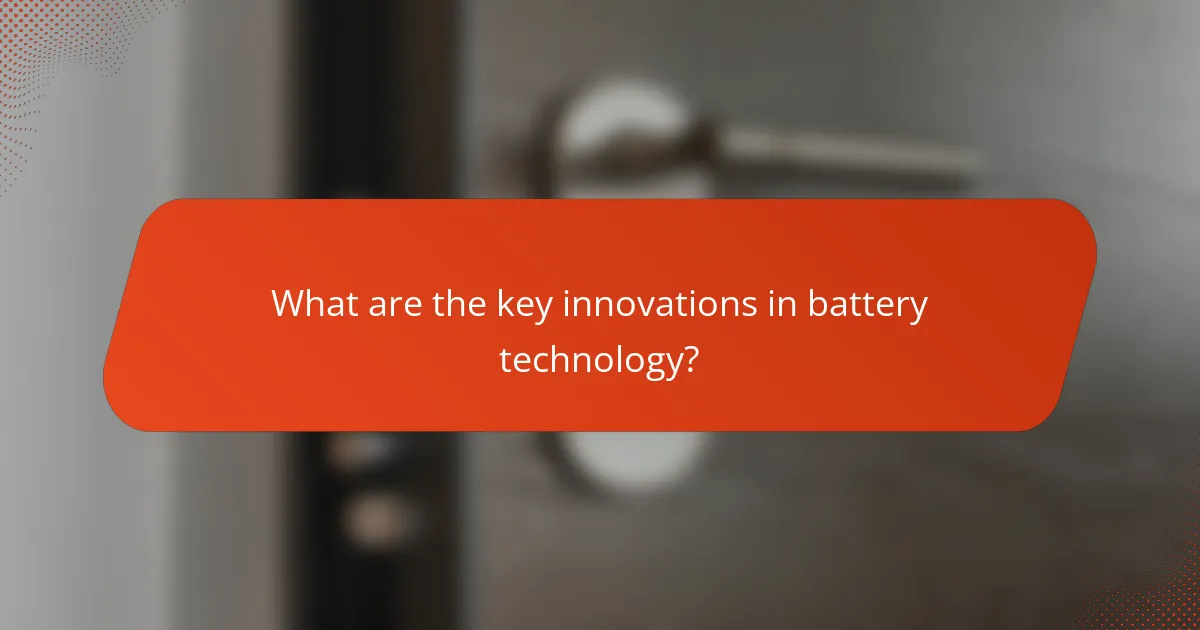
What are the key innovations in battery technology?
Key innovations in battery technology include solid-state batteries, lithium-sulfur batteries, and fast-charging technologies. Solid-state batteries utilize a solid electrolyte instead of a liquid one. This change enhances energy density and safety. Lithium-sulfur batteries promise higher capacity and lower costs compared to traditional lithium-ion batteries. Fast-charging technologies significantly reduce charging times, making electric vehicles more convenient. These innovations are supported by research showing that solid-state batteries can increase energy density by up to 50%. Additionally, lithium-sulfur batteries can potentially offer five times the energy capacity of current lithium-ion batteries. Overall, these advancements address charge times, lifespan, and environmental impact effectively.
How have charge times improved in modern batteries?
Charge times have significantly improved in modern batteries due to advancements in technology. Fast charging technologies, such as lithium-ion and solid-state batteries, allow for quicker energy transfer. For instance, some modern lithium-ion batteries can charge up to 80% in just 30 minutes. This is a substantial reduction compared to older models that required several hours for a full charge. Additionally, innovations like graphene batteries are emerging, promising even faster charge rates. Research indicates that these technologies can potentially reduce charge times to under 10 minutes for full capacity. Overall, these advancements enhance user convenience and device usability.
What technologies are driving faster charge times?
Fast charging technologies are primarily driven by advancements in battery chemistry, charging protocols, and thermal management systems. Lithium-ion batteries now utilize silicon anodes, which allow for greater energy density and faster electron movement. Ultra-fast charging protocols, such as Tesla’s Supercharger and Qualcomm’s Quick Charge, optimize power delivery to reduce charging time significantly.
Additionally, solid-state batteries are emerging as a game changer. They replace liquid electrolytes with solid materials, improving safety and charge rates. Research indicates that these batteries can achieve charge times of under 15 minutes for a full charge.
Thermal management systems also play a crucial role. Efficient cooling mechanisms prevent overheating during rapid charging, maintaining battery health and performance. Overall, these technologies collectively contribute to the significant reduction in charging times for modern batteries.
How do different battery chemistries affect charge time?
Different battery chemistries significantly affect charge time. Lithium-ion batteries typically charge faster than lead-acid batteries. For instance, lithium-ion can reach 80% charge in about 30 minutes. In contrast, lead-acid batteries may take several hours to achieve a similar charge level. Nickel-metal hydride batteries also exhibit slower charge times compared to lithium-ion. The internal resistance and chemical properties of each battery type influence these charge durations. Higher energy density in lithium-ion batteries contributes to their quicker charging capabilities. Additionally, advancements in fast-charging technologies further enhance the performance of specific chemistries.
What advancements have been made in battery lifespan?
Recent advancements in battery lifespan include the development of solid-state batteries. Solid-state batteries use solid electrolytes instead of liquid ones. This change enhances safety and increases lifespan. Research shows they can last up to 2,000 charge cycles. Lithium-sulfur batteries have also emerged, offering a theoretical lifespan of over 3,000 cycles. Additionally, improved battery management systems optimize charging. These systems help reduce wear and extend battery life. Innovations in materials, like silicon anodes, further boost longevity. These advancements collectively contribute to more durable and efficient batteries.
What factors contribute to increased battery lifespan?
Temperature control contributes to increased battery lifespan. Batteries operate best within a specific temperature range. Extreme heat can accelerate degradation of battery materials. Conversely, extreme cold can reduce battery efficiency. Charging practices also impact lifespan. Avoiding overcharging and deep discharging can enhance longevity. Regular partial charges are preferable to full discharges. Quality of materials influences battery durability. Higher quality components tend to withstand wear better. Additionally, proper maintenance routines can extend battery life. Regularly checking connections and cleaning terminals helps maintain efficiency.
How do usage patterns impact battery longevity?
Usage patterns significantly impact battery longevity. Frequent deep discharges can reduce battery life. Conversely, keeping the battery charged between 20% and 80% can extend its lifespan. High temperatures during usage can accelerate battery degradation. Additionally, using power-intensive applications can lead to faster battery wear. Research indicates that lithium-ion batteries last longer with moderate usage. Regularly charging the battery after partial discharges is beneficial. Maintaining optimal charging habits can enhance overall battery health.
What is the environmental impact of battery technology innovations?
Battery technology innovations have a significant environmental impact. New battery designs often utilize more sustainable materials. For instance, lithium-ion batteries have lower carbon footprints compared to traditional lead-acid batteries. Innovations also focus on recycling processes, reducing waste. Improved energy density means longer-lasting batteries, which decreases the frequency of replacements. Additionally, advancements in battery chemistry aim to minimize toxic components. According to the International Energy Agency, electric vehicle batteries can reduce greenhouse gas emissions by up to 70% over their lifecycle. Overall, these innovations contribute to a greener energy future.
How are new batteries designed to be more eco-friendly?
New batteries are designed to be more eco-friendly by utilizing sustainable materials and improving recyclability. Manufacturers are increasingly using lithium iron phosphate and other non-toxic materials. These materials reduce environmental harm compared to traditional battery components. Additionally, advancements in battery chemistry minimize reliance on rare earth metals. This shift decreases the ecological footprint associated with mining and production. Enhanced recycling processes are also being implemented. These processes recover valuable materials, reducing waste and promoting circular economy principles. Studies show that improved recycling can reclaim up to 95% of battery materials. Overall, these innovations aim to lessen the environmental impact of battery technologies.
What recycling methods are being developed for batteries?
Hydrometallurgical and pyrometallurgical methods are being developed for battery recycling. Hydrometallurgy involves using aqueous solutions to extract metals from battery materials. This method allows for the recovery of valuable metals like lithium, cobalt, and nickel. Pyrometallurgy, on the other hand, uses high temperatures to smelt batteries and separate metals. This process is effective for recycling lead-acid batteries and recovering lead. Additionally, direct recycling methods are being explored. These methods aim to retain the battery’s structure during recycling, enhancing efficiency. Research indicates that these methods can significantly reduce waste and improve metal recovery rates.
How do these innovations compare to traditional battery technologies?
Innovations in battery technology often outperform traditional battery technologies in several key areas. For instance, many new batteries offer significantly faster charge times, reducing the waiting period for users. Traditional lithium-ion batteries typically take hours to charge, while innovations like solid-state batteries can charge in minutes.
Additionally, innovations frequently provide longer lifespans. Traditional batteries may last for 500 to 1,000 charge cycles, while advanced technologies can exceed 2,000 cycles. This increased durability translates to less frequent replacements and lower long-term costs.
Moreover, environmental impact is a critical differentiator. Many new battery technologies aim to use more sustainable materials and reduce toxic waste. Traditional batteries often rely on materials like cobalt, which raises ethical and environmental concerns. Innovations are increasingly focused on recycling and minimizing resource extraction.
Overall, innovations in battery technology enhance performance, longevity, and sustainability compared to traditional battery technologies.
What challenges still exist in battery technology development?
Challenges in battery technology development include limited energy density, high costs, and safety concerns. Energy density affects how much energy a battery can store. Current lithium-ion batteries typically have an energy density of around 250 Wh/kg. This limits their application in electric vehicles and portable electronics. High production costs hinder widespread adoption. For instance, cobalt prices can significantly increase battery manufacturing expenses. Safety concerns arise from risks of overheating and fires, particularly in lithium-ion batteries. Research shows that over 200 incidents of battery fires have been reported in electric vehicles. Additionally, recycling and environmental impact pose challenges. Only about 5% of lithium-ion batteries are recycled effectively. These factors collectively impede advancements in battery technology.
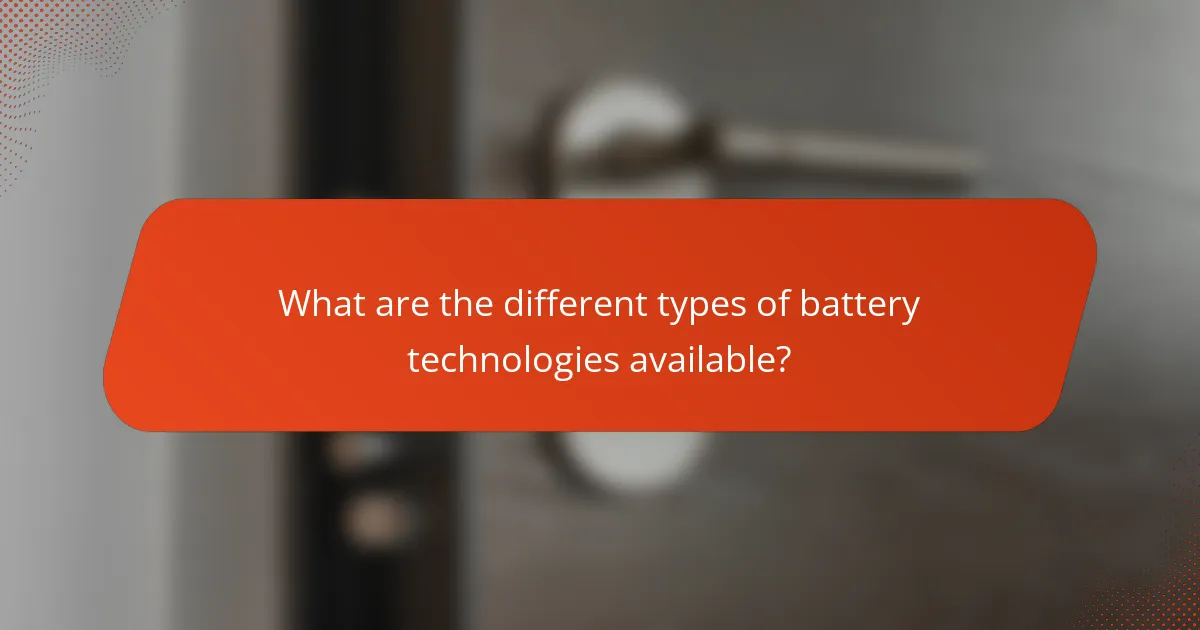
What are the different types of battery technologies available?
Lithium-ion, lead-acid, nickel-metal hydride, and solid-state are the main types of battery technologies available. Lithium-ion batteries are widely used in consumer electronics and electric vehicles due to their high energy density and efficiency. Lead-acid batteries are commonly used in automotive applications and are known for their reliability and low cost. Nickel-metal hydride batteries are often found in hybrid vehicles, offering a balance between performance and environmental impact. Solid-state batteries are an emerging technology that promises improved safety and energy density compared to traditional lithium-ion batteries. These various battery technologies cater to different needs and applications across industries.
What are the characteristics of lithium-ion batteries?
Lithium-ion batteries are rechargeable energy storage devices known for their high energy density. They typically have a voltage range of 3.2 to 4.2 volts per cell. Their energy density can reach up to 250 Wh/kg, making them efficient for various applications. Lithium-ion batteries exhibit low self-discharge rates, usually around 2-3% per month. They have a cycle life of 500 to 1,500 charge cycles, depending on usage and conditions. These batteries also feature lightweight designs, contributing to their portability. Additionally, they have built-in safety mechanisms to prevent overheating and overcharging. The environmental impact of lithium-ion batteries is a growing concern, particularly regarding resource extraction and recycling processes.
How do lithium-ion batteries differ from lead-acid batteries?
Lithium-ion batteries differ from lead-acid batteries primarily in energy density and lifespan. Lithium-ion batteries have a higher energy density, typically around 150-250 Wh/kg, compared to lead-acid batteries, which range from 30-50 Wh/kg. This means lithium-ion batteries can store more energy in a smaller and lighter package.
Additionally, lithium-ion batteries have a longer lifespan, often lasting 2,000 to 5,000 charge cycles, while lead-acid batteries typically last only 500 to 1,000 cycles. Lithium-ion batteries also have faster charging times, often reaching 80% charge in about 30 minutes, while lead-acid batteries can take several hours to charge fully.
Moreover, lithium-ion batteries have a lower self-discharge rate, around 2-5% per month, compared to lead-acid batteries, which can lose 10-20% of their charge monthly. This efficiency contributes to their growing use in modern applications, such as electric vehicles and portable electronics.
What specific applications benefit from lithium-ion technology?
Lithium-ion technology benefits several specific applications. These applications include consumer electronics, electric vehicles, renewable energy storage, and medical devices. In consumer electronics, lithium-ion batteries power smartphones, laptops, and tablets due to their high energy density. Electric vehicles utilize lithium-ion technology for efficient energy storage and longer driving ranges. Renewable energy systems, such as solar and wind, rely on lithium-ion batteries to store energy for later use. Medical devices, including portable equipment and implantable devices, also depend on lithium-ion batteries for their reliability and compact size. The versatility of lithium-ion technology makes it essential across these diverse fields.
What emerging battery technologies are on the horizon?
Solid-state batteries are emerging as a promising technology on the horizon. They utilize a solid electrolyte instead of a liquid one. This design enhances safety by reducing fire risks. Solid-state batteries also offer higher energy density. They can potentially double the range of electric vehicles. Another technology gaining attention is lithium-sulfur batteries. These batteries can store more energy than traditional lithium-ion batteries. They may also have a lower environmental impact. Research indicates that lithium-sulfur batteries can achieve higher cycle life. Furthermore, developments in sodium-ion batteries are underway. Sodium-ion batteries use abundant materials, making them cost-effective. They are seen as a viable alternative to lithium-ion technology.
How do solid-state batteries improve upon current technologies?
Solid-state batteries improve upon current technologies by utilizing solid electrolytes instead of liquid ones. This design enhances safety by reducing the risk of leaks and fires. Solid-state batteries also offer higher energy density, which allows for longer usage times between charges. They typically have a longer lifespan due to reduced wear and tear on components. Additionally, solid-state batteries can operate effectively in a wider temperature range. Studies show that they can achieve faster charging times compared to traditional lithium-ion batteries. Overall, these advancements lead to more efficient and reliable energy storage solutions.
What role do flow batteries play in energy storage solutions?
Flow batteries serve a crucial role in energy storage solutions by enabling large-scale energy storage and discharge. They utilize two electrolyte solutions separated by a membrane to store energy chemically. This design allows for easy scalability, making them suitable for renewable energy applications. Flow batteries can efficiently store excess energy generated from sources like solar and wind. Their ability to provide long-duration energy discharge sets them apart from conventional batteries. Additionally, flow batteries have a longer lifespan and lower environmental impact due to their recyclable materials. Studies show that flow batteries can support grid stability and enhance energy management systems.
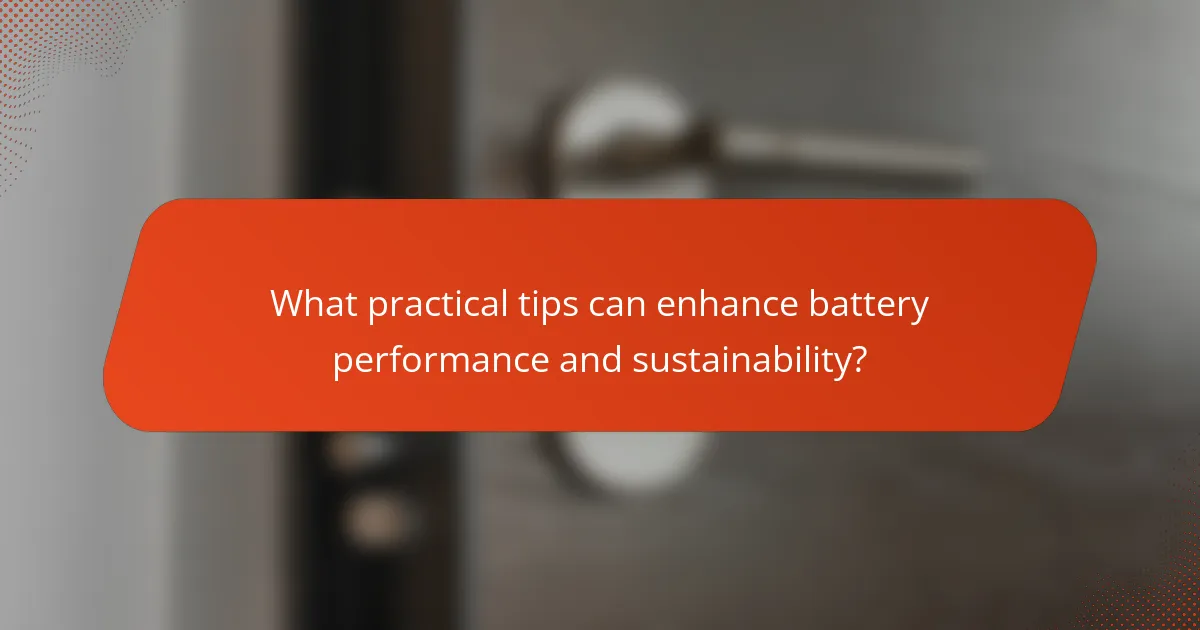
What practical tips can enhance battery performance and sustainability?
To enhance battery performance and sustainability, users should implement several practical tips. Regularly calibrating the battery can optimize its performance. Keeping the battery between 20% and 80% charge can prolong its lifespan. Avoiding extreme temperatures is essential, as heat can degrade battery health. Using the original charger ensures compatibility and efficiency during charging. Limiting background applications reduces power consumption and extends battery life. Additionally, enabling power-saving modes can conserve energy during usage. These practices align with guidelines from battery manufacturers, which emphasize temperature control and charge management for optimal battery health.
How can users extend the lifespan of their batteries?
Users can extend the lifespan of their batteries by following specific practices. Regularly charging batteries to 80% instead of 100% can reduce stress on the battery. Avoiding deep discharges, such as letting the battery drop below 20%, helps maintain its health. Keeping batteries at moderate temperatures is crucial; extreme heat or cold can degrade performance. Using battery-saving modes on devices can also prolong battery life. Additionally, minimizing background app activity reduces energy consumption. Following these guidelines can significantly enhance battery longevity.
What charging practices should be followed for optimal battery health?
To maintain optimal battery health, follow these charging practices. Charge your device between 20% and 80% capacity. Avoid letting the battery drain completely or charging to 100% frequently. Use the original charger to ensure proper voltage and current. Keep your device cool while charging, as heat can degrade battery life. Avoid overnight charging to prevent prolonged exposure to high voltage. Regularly update your device’s software for optimized charging algorithms. These practices can extend battery lifespan and efficiency significantly. Research indicates that lithium-ion batteries last longer with these charging habits.
What maintenance tips can help users get the most out of their batteries?
Regularly charging batteries to about 80% can enhance their lifespan. Avoid discharging batteries completely before recharging. Keeping batteries at moderate temperatures increases their efficiency. Store batteries in a cool, dry place when not in use. Use the manufacturer’s recommended charger to prevent damage. Periodically check for corrosion on terminals and clean them as necessary. Avoid exposing batteries to extreme heat or cold, as this can degrade performance. Following these tips can help users maximize battery longevity and efficiency.
The main entity of this article is battery technology, focusing on key innovations that enhance charge times, lifespan, and environmental impact. It covers advancements such as solid-state and lithium-sulfur batteries, which improve energy density and safety, as well as fast-charging technologies that significantly reduce charging durations. The article also addresses factors affecting battery lifespan, including usage patterns and temperature control, while highlighting the environmental benefits of new battery designs and recycling methods. Overall, it provides a comprehensive overview of how these innovations compare to traditional battery technologies and the challenges that remain in their development.
